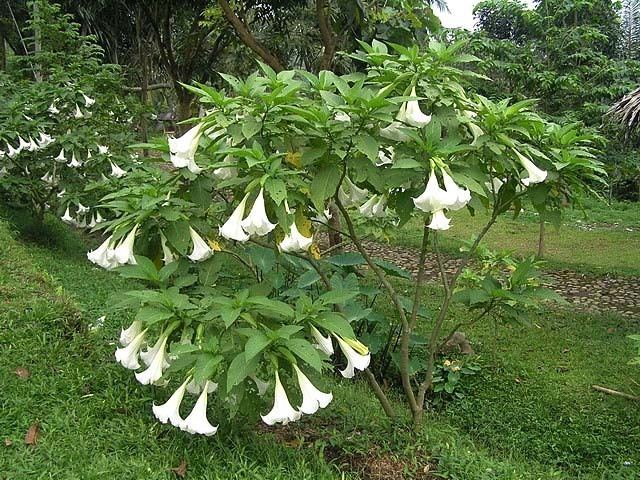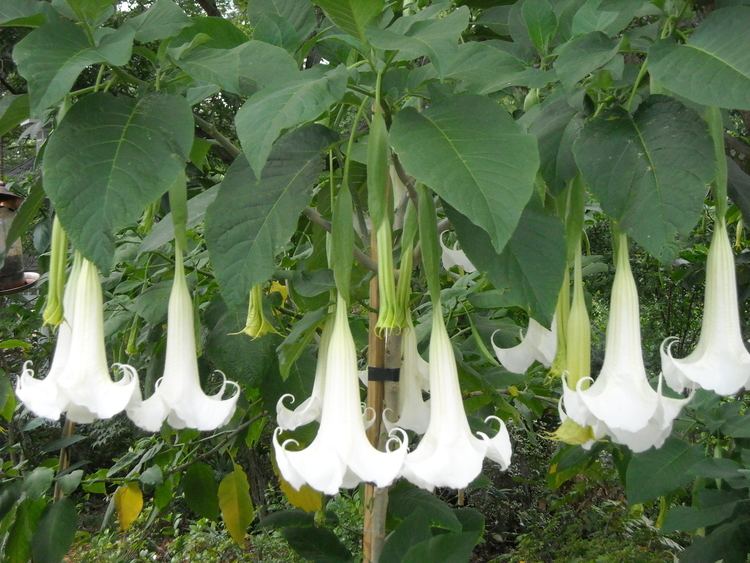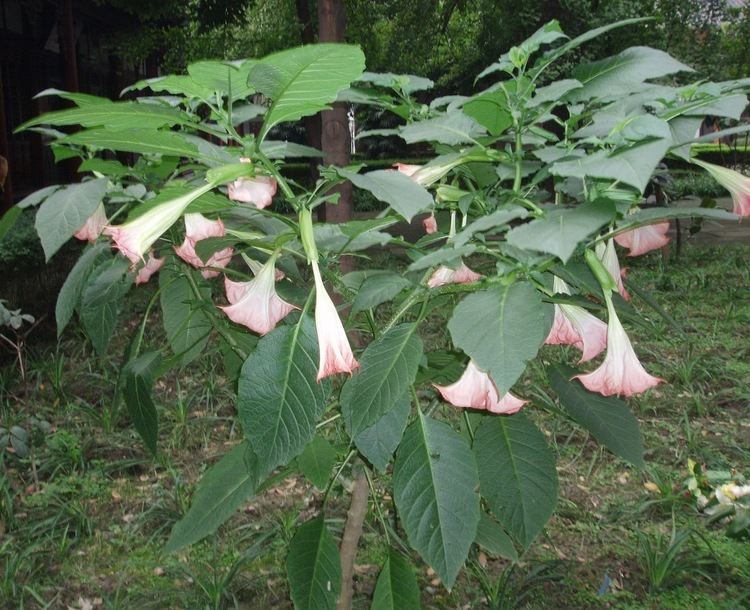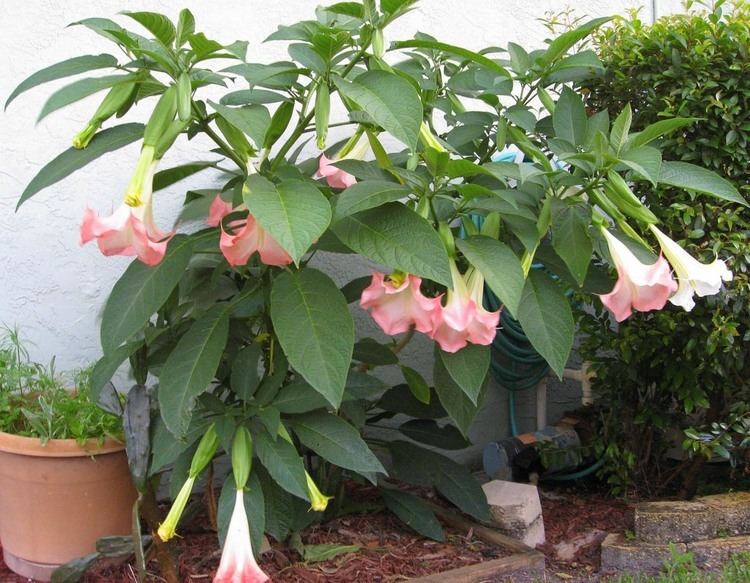Rank Species | Genus Brugmansia Higher classification Brugmansia | |
 | ||
Similar Brugmansia, Angel's trumpets, Brugmansia arborea, Nightshade, Brugmansia sanguinea | ||
Urban brugmansia suaveolens scopolamine
Brugmansia suaveolens, Brazil's white angel trumpet, also known as angel's tears, is a South American species of flowering plants that grow as shrubs or small trees with large fragrant flowers.
Contents
- Urban brugmansia suaveolens scopolamine
- Urban brugmansia suaveolens stabilized version
- Description
- Taxonomy
- Distribution and habitat
- Ecology
- Uses
- Culture
- Toxicity
- References

Urban brugmansia suaveolens stabilized version
Description

Brugmansia suaveolens is a semi-woody shrub or small tree, growing up to 3–5 m (10–16 ft) tall, often with a many-branched trunk. The leaves are oval, to 25 cm (10 in) long by 15 cm (6 in) wide, and even larger when grown in the shade. The flowers are remarkably beautiful and sweetly fragrant, about 24–32 cm (9–13 in) long and shaped like trumpets. The corolla body is slightly recurved to 5 main points, but the very peaks in the true species are always curved outwards, never rolled back, and these peaks are short, only 1–2.5 cm (0.4–1.0 in) long. The flowers are usually white but may be yellow or pink and hang downward from fully pendulous up to nearly horizontal.
Taxonomy

First discovered by Alexander von Humboldt and Aimé Bonpland, Brugmansia suaveolens was first formally described and published by Carl Ludwig Willdenow in 1809 as Datura suaveolens. In 1823, Friedrich von Berchtold and Jan Presl transferred these to Brugmansia suaveolens. Local common names include Maikoa, Huanduc, Maikiua, Tompeta del jucio, Tsuaak, Toe, Wahashupa, Peji, Bikut, Ohuetagi, Ain-vai, Baikua, Canachiari, and Ishauna. There are thousands of cultivated Brugmansia hybrids, and the majority have at least some B. suaveolens heritage. Some of the more popular cultivars include 'Dr. Seuss', 'Frosty Pink' and 'Charles Grimaldi'.
Distribution and habitat

This Angel Trumpet was originally endemic to the coastal rainforests of south-east Brazil, where it grows below 1,000 m (3,300 ft) along river banks and forest edges with warm temperatures, high humidity, and heavy rainfall. As a result of human interaction with this species, it can now be found growing in residential areas throughout much of South America; and occasionally in Central America, Mexico, California and even in parts of Florida.
Ecology

Fragrant in the evenings to attract pollinating moths, they hang half-closed during the day, but return to their peak again in the evenings. Brugmansia have two main stages to their life cycle. In the initial vegetative stage the young seedling grows straight up on usually a single stalk, until it reaches its first main fork at 80–150 cm (2.6–4.9 ft) high. It will not flower until after it has reached this fork, and then only on new growth above the fork. Cuttings taken from lower vegetative region must also grow to a similar height before flowering, but cuttings from the upper flowering region will often flower at a very low height.
One interesting example of plant/animal interaction involves the butterfly Placidula euryanassa, who uses Brugmansia suaveolens as one of its main larval foods. It has been shown that these can sequester the plant's tropane alkaloids and store them through the pupal stage on to the adult butterfly, where they are then used as a defense mechanism, making themselves less palatable to vertebrate predators.
Uses
Many South American cultures use Brugmansia suaveolens ritually. The Ingano and Siona in the Putumayo region both use it as an entheogen. It is also used by some Amazonian tribes as an admixture to increase the potency of Ayahuasca. The flowers and the seeds are traditionally used in Rio Grande do Sul, southern Brazil, mixed in water and ingested for its analgesic-like effect.
Flower extracts have shown pain-killing (antinociceptive) activity in mice. This antinociceptive activity may be related in part to benzodiazepine receptors.
B. suaveolens is included in the Tasmanian Fire Service's list of low flammability plants, indicating that it is suitable for growing within a building protection zone.
Culture
Brugmansia are grown as ornamentals outdoors year-round in non-freezing climates around the world. Like other large-leaved, fast-growing plants, they appreciate a little protection from the wind, as well as from the hottest afternoon sun. They like organically rich soil, frequent water, and heavy fertilizer when in full growth. Both woody and leafy tip cuttings are used to propagate Brugmansia, although thicker cuttings tolerate lower humidity. In northern climes they are often grown out in large containers and wintered over in non-freezing garages or basements.
Toxicity
Every part of Brugmansia suaveolens is poisonous, with the seeds and leaves being especially dangerous. As in other species of Brugmansia, B. suaveolens is rich in scopolamine (hyoscine), hyoscyamine, atropine, and several other tropane alkaloids. Effects of ingestion can include paralysis of smooth muscles, confusion, tachycardia, dry mouth, diarrhea, visual and auditory hallucinations, mydriasis, rapid onset cycloplegia, and death.
